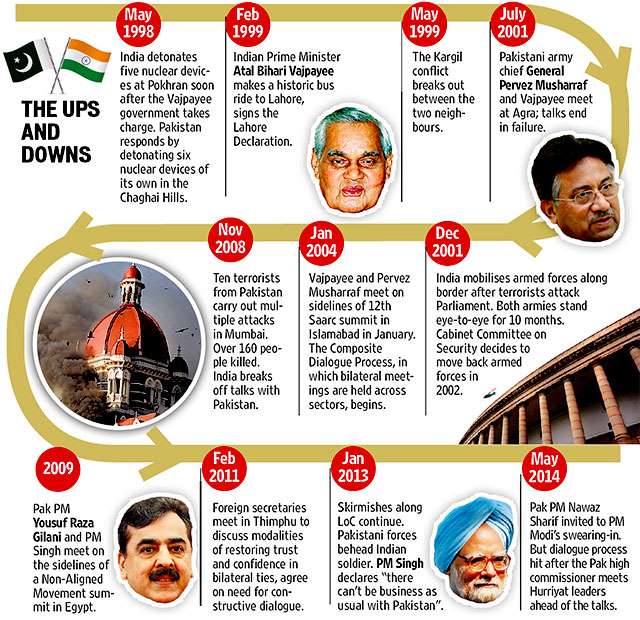July 11, 2015
Ufa, RUSSIA – The greatest foreign policy difference between Prime Minister Narendra Modi and his predecessor Manmohan Singh has been Pakistan. Singh believed in dialogue with Pakistan at almost any cost.

July 11, 2015
Ufa, RUSSIA – The greatest foreign policy difference between Prime Minister Narendra Modi and his predecessor Manmohan Singh has been Pakistan. Singh believed in dialogue with Pakistan at almost any cost.

Prime Minister Narendra Modi with Pakistani Prime Minister Nawaz Sharif at the Shanghai Cooperation Organization summit in Ufa, Russia on Friday. (PTI Photo)
Modi’s views were more akin to those of ex-PM PV Narasimha Rao: Dealing with Pakistan was high risk, low return and not worth the investment.
However, official sources say, Modi recognised he could not take a hardline stance on Pakistan without lines of communication to Islamabad — this would let Pakistan talk up the “nuclear flashpoint” claim and encourage international pressure to build up.
But India wanted to bury the 26/11 tainted composite dialogue and make the agenda about terror. So Modi began to embed all official meetings with Pakistan within the Saarc. His endless neighbourhood tours, overtures to China, and back-to-back summits with Barack Obama also drove home to Pakistan its global pariah status.
India’s message to Pakistan was not that we won’t talk, but that any conversation would be about tangibles regarding terror. New Delhi would not be diverted: India was the global power-in-the-making, Pakistan the failing state. “We expected a long impasse,” said a source. “The question was who would crack?”
The answer is now clear: Pakistan.
The joint statement is noticeable for its lack of an explicit mention of Kashmir and that three-quarters of its text is terror related. It replaces the composite dialogue with a new line-up of bilateral meetings. And it sets tests for Pakistan like 26/11-related voice samples.
India accepts the Pakistani leader Nawaz Sharif went the extra mile at the meeting and at some political cost at home.

It was evident for several months that Pakistan’s “confidence levels had been falling.” To some degree, this had reached dangerous levels. The US and other foreign governments had warned India that the combination of harsh language by Modi’s ministers, the LoC exchanges and the Myanmar raid had jacked up Pakistan’s neurotic fears of an Indian threat. Intelligence showed that the Pakistan military had been expanding its engagement with militant groups – a possible precursor to a terrorist strike.
Even a symbolic gesture to Islamabad, the case was made to New Delhi, would help reduce the rising paranoia in Rawalpindi.
Modi got what he wanted: An agenda on his terms. Pakistan, the world got what they wanted: Talks, of whatever kind.
Courtesy: HT
















































































































